
Bubalus is a genus of Asiatic bovines that was proposed by Charles Hamilton Smith in 1827. Bubalus and Syncerus form the subtribe Bubalina, the true buffaloes.

The Last Interglacial, also known as the Eemian among other names was the interglacial period which began about 130,000 years ago at the end of the Penultimate Glacial Period and ended about 115,000 years ago at the beginning of the Last Glacial Period. It corresponds to Marine Isotope Stage 5e. It was the second-to-latest interglacial period of the current Ice Age, the most recent being the Holocene which extends to the present day. During the Last Interglacial, the proportion of CO2 in the atmosphere was about 280 parts per million. The Last Interglacial was one of the warmest periods of the last 800,000 years, with temperatures comparable to and at times warmer than the contemporary Holocene interglacial, with the maximum sea level being up to 6 to 9 metres higher than at present, with global ice volume likely also being smaller than the Holocene interglacial.
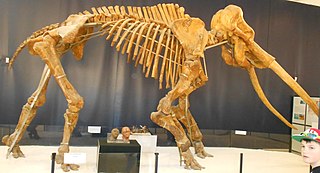
Palaeoloxodon is an extinct genus of elephant. The genus originated in Africa during the Early Pleistocene, and expanded into Eurasia at the beginning of the Middle Pleistocene. The genus contains some of the largest known species of elephants, over 4 metres (13 ft) tall at the shoulders, including the African Palaeoloxodon recki, the European straight-tusked elephant and the South Asian Palaeoloxodon namadicus. P. namadicus has been suggested to be the largest known land mammal by some authors based on extrapolation from fragmentary remains, though these estimates are highly speculative. In contrast, the genus also contains many species of dwarf elephants that evolved via insular dwarfism on islands in the Mediterranean, some only 1 metre (3.3 ft) in height, making them the smallest elephants known. The genus has a long and complex taxonomic history, and at various times, it has been considered to belong to Loxodonta or Elephas, but today is usually considered a valid and separate genus in its own right.

The Würm glaciation or Würm stage, usually referred to in the literature as the Würm, was the last glacial period in the Alpine region. It is the youngest of the major glaciations of the region that extended beyond the Alps themselves. Like most of the other ice ages of the Pleistocene epoch, it is named after a river, in this case the Würm in Bavaria, a tributary of the Amper.
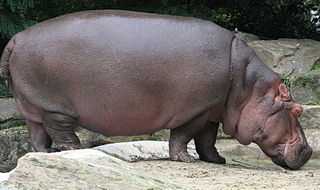
Hippopotamus is a genus of artiodactyl mammals consisting of one extant species, Hippopotamus amphibius, the river hippopotamus, and several extinct species from both recent and prehistoric times. It belongs to the family Hippopotamidae, which also includes the pygmy hippopotamus and a number of extinct genera.

An interglacial period is a geological interval of warmer global average temperature lasting thousands of years that separates consecutive glacial periods within an ice age. The current Holocene interglacial began at the end of the Pleistocene, about 11,700 years ago.
European buffalo may refer to:

The straight-tusked elephant is an extinct species of elephant that inhabited Europe and Western Asia during the Middle and Late Pleistocene. It was larger than any living elephant, with adult males suggested to reach 3.81–4.2 metres (12.5–13.8 ft) in shoulder height, and 11.3–15 tonnes in weight. Like modern elephants, the straight-tusked elephant lived in herds, flourishing during interglacial periods, when its range would extend as far north as Great Britain. Skeletons found in association with stone tools and wooden spears suggest they were scavenged and hunted by early humans, including Neanderthals. It is the ancestral species of most dwarf elephants that inhabited islands in the Mediterranean.

Palaeoloxodon falconeri is an extinct species of dwarf elephant from the Middle Pleistocene of Sicily and Malta. It is amongst the smallest of all dwarf elephants at only 1 metre (3.3 ft) in height. A member of the genus Palaeoloxodon, it derived from a population of the mainland European straight-tusked elephant.
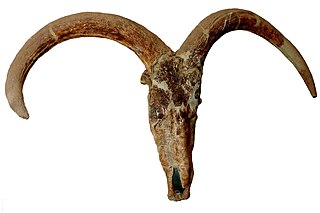
Pelorovis is an extinct genus of African wild cattle which existed during the Pleistocene epoch. The best known species is Pelorovis oldowayensis from Olduvai Gorge in Tanzania, from the Early Pleistocene. The species "Pelorovis" antiquus from the Late Pleistocene-Holocene has since been moved into Syncerus, the same genus as living African buffalo.
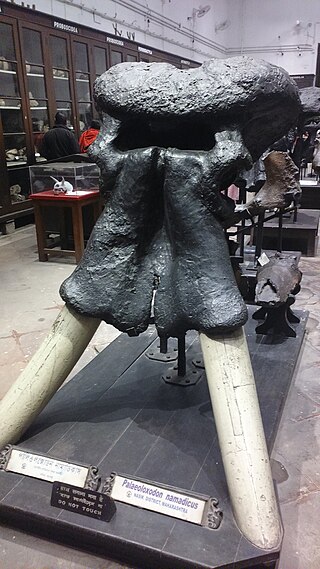
Palaeoloxodon namadicus is an extinct species of prehistoric elephant known from the early Middle to Late Pleistocene of the Indian subcontinent, and possibly also elsewhere in Asia. The species grew larger than any living elephant, and some authors have suggested it to have been the largest known land mammal based on extrapolation from fragmentary remains, though these estimates are speculative.

Hippopotamus antiquus is an extinct species of Hippopotamus that ranged across Europe during the Early and Middle Pleistocene.

Palaeoloxodon cypriotes is an extinct species of dwarf elephant that inhabited the island of Cyprus during the Late Pleistocene. The species became extinct around 12,000 years ago, around the time humans first colonised Cyprus.

The Saale glaciation or Saale Glaciation, sometimes referred to as the Saalian glaciation, Saale cold period, Saale complex (Saale-Komplex) or Saale glacial stage, covers the middle of the three large glaciations in Northern Europe and the northern parts of Eastern Europe, Central Europe and Western Europe by the Scandinavian Inland Ice Sheet. It follows the Holstein interglacial and precedes the Eemian interglacial, spanning from around 400,000 years ago to 130,000 years ago. The Saalian covers multiple glacial cycles punctuated by interglacial periods. In its latter part it is coeval with the global Penultimate Glacial Period.
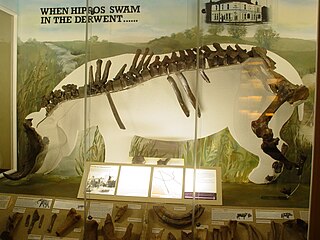
The Allenton Hippo is a hippopotamus skeleton that was found in Allenton, Derby, England, in 1895. The skeleton is exhibited in Derby Museum and Art Gallery and is 3 metres (9.8 ft) in length. It is celebrated today in a sculpture near to where the skeleton was discovered.

Syncerus antiquus is an extinct species of buffalo from the Late Pleistocene and Holocene of Africa. It was one of the largest species in its family, potentially weighing up to 2,000 kilograms (4,400 lb). Due to this fact, it is sometimes known as the African giant buffalo. The time of its extinction is of debate; Syncerus antiquus either became extinct at the end of the Late Pleistocene about 12,000 years ago or during the Holocene, some 4,000 years ago.

The narrow-nosed rhinoceros, also known as the steppe rhinoceros is an extinct species of rhinoceros belonging to the genus Stephanorhinus that lived in western Eurasia, including Europe, as well as North Africa during the Pleistocene. It first appeared in Europe some 600,000 years ago during the Middle Pleistocene and survived there until at least 34,000 years Before Present.

Stephanorhinus kirchbergensis, also known as Merck's rhinoceros or the forest rhinoceros, is an extinct species of rhinoceros belonging to the genus Stephanorhinus from the Middle to Late Pleistocene of Eurasia. Its range spanned from western Europe to eastern Asia. Among the last members of the genus, it co-existed alongside Stephanorhinus hemitoechus in the western part of its range.
Bubalus fudi is an extinct relative of water buffalo, which survived in the late Pleistocene.
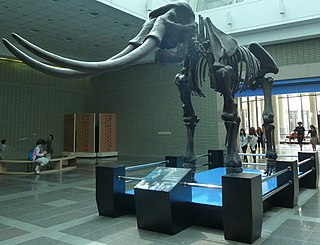
Palaeoloxodon huaihoensis is an extinct species of elephant belonging to the genus Palaeoloxodon known from the Pleistocene of China.

















